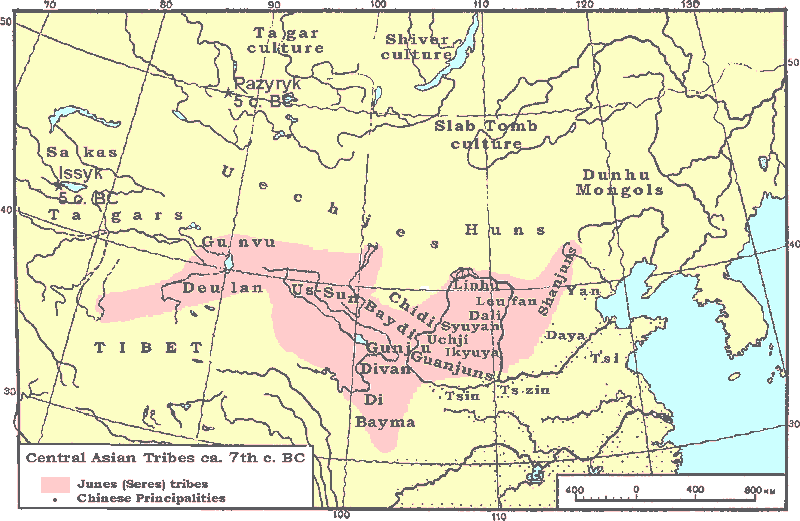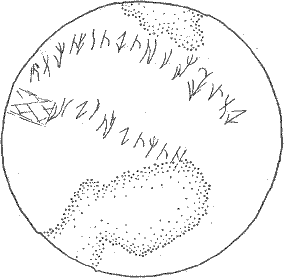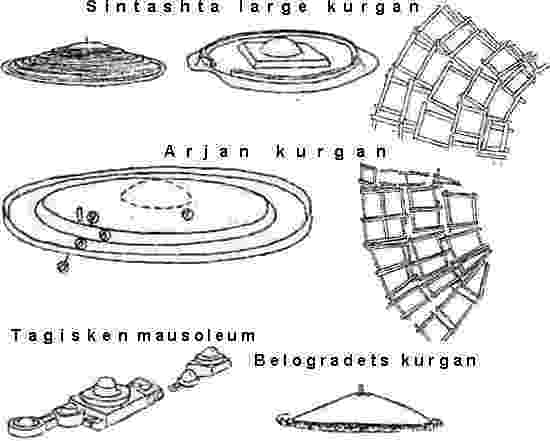| Kurgan Culture Contents | |
|
Why Pazyryk? A look at Kurgans 1. Pazyryk mtDNA Genetics - M.I.Voevoda 2. Pazyryk mtDNA Genetics - I.V.Kulikov Pazyryk Craniology - Tur S.S. |
Pazyryk Timing - L.S. Marsadolov 14C Euroasian Timing 3,000 BC-50 AD - A.Yu.Alekseev et. al. Modern Türks of Pazyryk Descend - Tur S.S. |
Почему Пазырык? Взгляд на Курганы
Links
Foreword
Pazyryk culture From Wikipedia, the free encyclopedia.
The Pazyryk culture (ca. 5th century BC (click on Pazyryk Timing to see real dating) refers to an archaeological culture identified by excavated artefacts and mummified humans in the Siberian permafrost. The mummies are buried in kurgans similar to the kurgans of western Scythian culture in modern Ukraine. Archaeologists associate the sites with the widespread Scythian culture of the steppe. The vessels excavated from the tombs are similar to ones still in use today by indigenous groups.
Altaic peoples still profess beliefs that relies heavily on their kam's (aka shaman's) intellectual and spiritual knowledge, there is a belief that the disturbed sanctity are causing increased suicides, sickness and earthquakes in the region and hence the corps must be brought back to their origins to stop the chaos. (Evidently, the consensus that contributed to Wikipedia never went in their education beyond the folk stories about shamans and their primitive, in comparison with the enlightened writers, superstitions)
* * *
Ever since the first investigations in the 1920es, the Irano-enthusiasts labeled the Pazyryk people and their Scythian culture as invariably Iranian-lingual, building a variety of conjectures to fit the facts back into their Indo-European schemes. Lately, however, the Iranian label tends to melt away, turning a glorious expression "Iranian-lingual Scythians" into a bleak and un-IE-patriotic simple "Scythians", and the vestiges of the former glorious "Iranian-lingual", scattered everywhere in the scientific literature, and carrying very pronounced racial overtones, serve as a reminder of the past centuries' scientific anopia. Even now, in their scientific quests, investigators still succeed in "getting surprised" at every corner, discovering along the way that the eternal truths they were brought up with were conjured at odds with unpretentious reality.
The scientific investigation is in its baby steps only, we have a glimpse at mtDNA of the maternal lineages, as an aggregate value not resolved properly in time. Knowing that the moms as a group had Paleosiberian genes is just a small step, we still want to know the composition of the pops, and their horses, and their accurate timing, and the bacteria used to make kumiss, and many many
Like an aircraft carrier fleet of today, the elite (aka "royal") kurgans are a most visible manifestation of the kurgan burial phenomenon, foreshadowing thousands of secondary, tertiary, and laymen kurgans that accompany each elite kurgan. The elite kurgans are spread in a huge territory and spread greatly in time. Appearing first around the Urals area, the elite kurgans drift eastward, before doubling back toward the N.Pontic. In the belt from the Caspian Sea to China, the kurgan traditions in places survived to the present times, but in the N.Pontic area the kurgan tradition largely faded away in a few centuries after Chingizid conquest, most likely as a consequence of the Islamic influence that rose in response to forced Christianization after the demise of the Kipchak Khanaate. Ironically, the Christianizators dropped the ball and allowed newly baked Christians to continue a combined Christian-Kurgan tradition for a few more centuries, as was found by "surprised" archeologists who at first did not expect to find Christian symbols in the kurgan burials, while the newly converted Moslems had to abandon immediately and stringently any pre-Moslem rituals.
A little gallery below displays some kurgans not shown elsewhere in these pages.
| 175 |
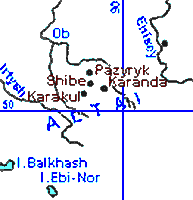 |
|||||
|
Kurgans of Andronov Culture and Early Scythian time
|
Sintashta, ca 1650 BC
(non-calibrated), S.Urals Sintashta kurgan is a "ziggurat", erected above a tomb of a leader built at the level of ancient surface (like in Arjan). A 9-tier stepped pyramid, with base diameter 72 m, initial height 9 m, rests on a base of huge wooden cells of 2-3 steps each, built in concentric circles in pairs with each subsequent layer offset from the edge of the previous layer. Internal space of kurgan and cells were filled with reed sheaves and earth. On the top of the kurgan was a level platform covered with log deck with a spherical dome, at its top was a stele, visualized by the excavators inebriated with Avasta fumes as a "tree of life" column, but from the traditions of their direct descendents, N.Pontic Kipchaks, a regular upright memorial slab like any modern tombstone, much later called a sword by Herodotus. On the landing of each tier were installed wooden columns (in two cases their remains were preserved), these are also analogous to the side columns of the kurgans left by N.Pontic Kipchaks. On the Sintashta settlement the base of defensive walls was also made of timber cells, showing a tradition of using this construction method. Later, archeologists noted this distinctive feature of stone cells filled with refuge and earth in the Khazarian and Bulgarian structures. Tagisken, 8-5 cc. BC, S. Aral |
|||||
| 45 | Arjan kurgan, ca 750±50 BC (calibrated) | |||||
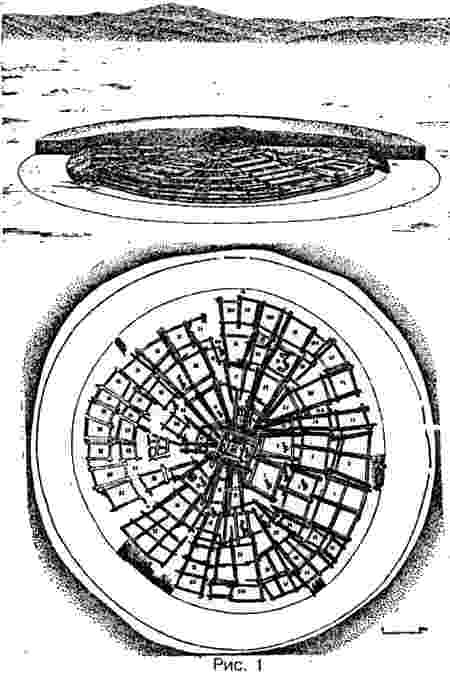 |
One of the earliest examples of Scythian kurgans is Kurgan Arjan, instrumentally dated 800±50 BC. In a circle 120 meters diameter lays a timbered central tomb, on the periphery in 13 places were laid over 160 riding horses. The earthworks for the kurgan complex moved 21,000 cubic meters of earth, or something like 100,000 cart or saddlebag horse trips. The funeral memorial feast fed the mourners at least 300 horses. Analysis of the horse bridles types shows that gifts were brought by members of confederation with differing cultural traditions. The origin of Arjan elite riding burials is a modification of the burials of the most elite "carriage" leaders developed in the society of the Andronov Culture. The closest direct descendents of Pazyryk population are Tubalars, Mountain Shors, Kumandins (Kumans), and Teleuts, Bashkirs and Koybalys, based on the craniological studies. Most of the these modern groups directly ascend to Tele (Chinese Gaogüys = High Wheels => Tele = Wheels) confederation known from the Chinese annals. |
|||||
| Kurgan 17 Badanka 4, Mount Badanka, Krasnoyarsk Province, 8th - 5th c. BC | ||||||
|
|
Complex of kurgan burials in the foorhils of the Mount Bodanka, in the valley of r. Us in Ermak district of Krasnoyarsk Province, 28 kurgans of 8th - 5th c. BC (non-instrumental eyeball dating) with diameter of 7 to 50 m and height of 2.5 m max, with round and rectangular fencing. Tombs are covered with decks, burials with horses, decking includes "deer stelae". |
|||||
| Salbyk
kurgan, 5th-4th c.BC, Upper Enisey-Irtysh interfluvial Height 25-30 m, 500 m diameter total complex, under kurgan a monumental stone fence, 70x70 m rectangular, and other structures |
||||||
 |
Kurgan is classed as belonging to Tagar (aka Tochar) Culture, with temporary settlements during defense, irrigational hoe agriculture, predominant cattle breeding, herds of cows, sheep, horses, deer. Timber and saman (adobe) dwellings next to yurts. Timber grave tombs, slab fencing, both males and females are armed, Kurgan Salbyk belongs to the late stage of the Tagar Culture, robbed in antiquity, many artifacts belong to Scythian Culture: copper kazans (cauldrons) with graceful stand, type of daggers, horse harness, arrows, animal stile art. |
|||||
| Eastern Kazakhstan Chilik valley kurgans, 8th-5th c. BC | ||||||
| Picture missing |
In Eastern Kazakhstan in Chilik valley is a group of kurgans with diameter 20-100 meters and height of 8-17 meters. One of them has diameter 66 m archeologically dated bythe 8th-7th c. BC . Its construction volume is estimated 34,000 m3. |
|||||
| Kurgan Meadow Grave (Lugovaya Mogila), | ||||||
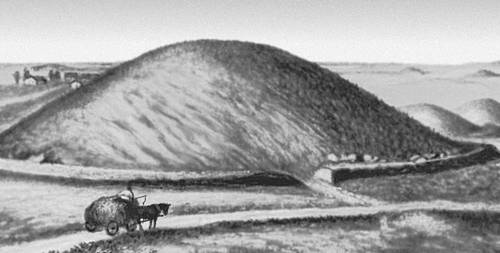 |
Description missing Note other kurgans in the picture |
|||||
| 135 | ||||||
|
Kurgan 4, Field 111, Upper Askiz burial field, Khakassia Height appr. 1 m, slab fence 13 x 13 m, one slab has pictograph of standing deers, another slab has a human figure 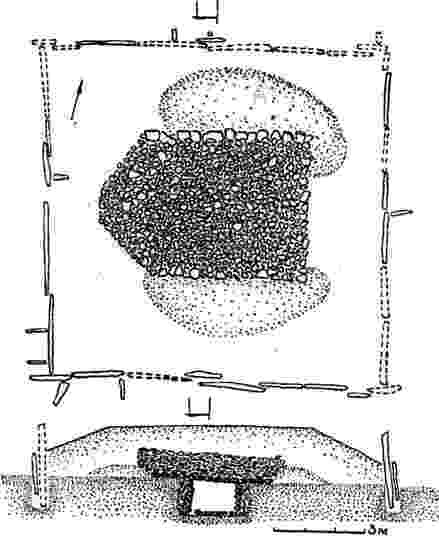 |
Kurgan bear Bagül Mountain Early Tagar Culture kurgan, slab fence 18 x 17 m, corner and middle stelae up to 2.8 m, images of Okun epoch (i.e. deer), bull and censer. Kurgan made of rocks over 1 m in height, tiled with massive slabs 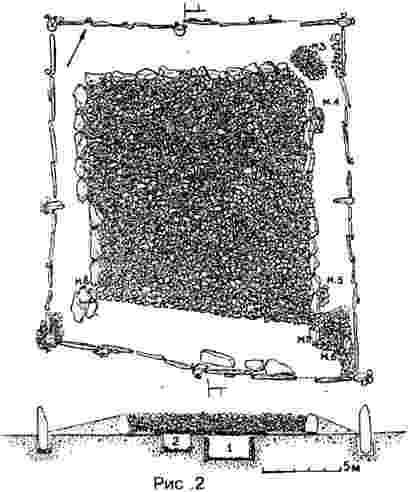 |
|||||
|
Kurgan 1, Upper Askiz burial field Togr-Tag,
Khakassia, Height more then 1 m, earthen kurgan diameter 30 m, slab fence 20,0 x 17,0 m, 8 high stelae, slabs and stelae depict images of Okun epoch (i.e. deer), people and animals of Karasük and Scythian time (8th - 2nd c.BC.) 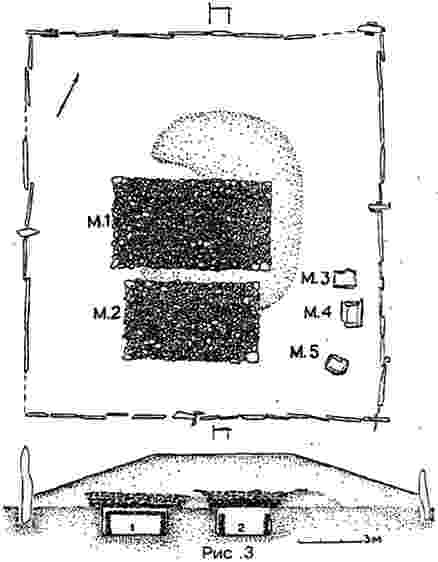 |
||||||
| 182 |
Kurgan complex Dikiltas 4th c. BC, NE coast of Caspian Sea |
|||||
|
General view, complex consist of central chamber 11 m in diameter, dromos, memorial-sacrificial ring, firepits and stelae (mengir, dikiltash, "deer stelae") with tamgas 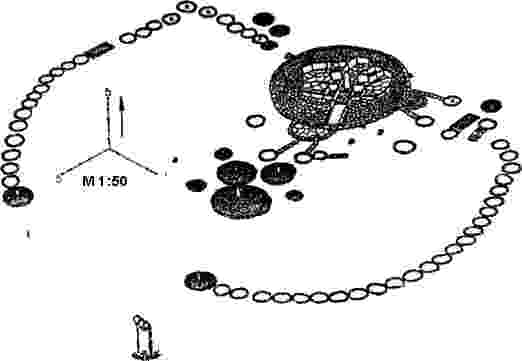
|
Central chamber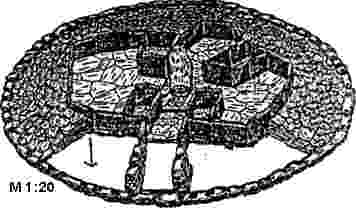
|
|||||
Other notable but not known |
||||||
|
Group of the tombs presumably belonging to Saka (i.e. Sogdy=Sogdian) leaders is concentrated
in Jeti-Su in a valley Basshatyr. By now all kurgans of the Steppe Scythia which could be considered as elite tombs of the 4th c. BC were investigated. 30 largest kurgans of the Dnieper area are a fourth group with height from 14 to 21 meter, including Chertomlyk, Alexandropol, Oguz, Big Tsimbalka and Kozel 14 can be classed as elite tombs. These are the most mighty burial structures of the East Europe: Soloha with kurgan volume 52,000 cubic meters, Alexandropol with 77,500 m3, Chertomlyk with 82000 m3, and Oguz with 117,000 m3, Nechaeva Tomb with 16 м height, Kozel and Tsimbalka with volume of 33,000 and 32,000 cubic meters. Elite burials are in Kuban, in Kelermes. Kelemess Kurgan No 1 belongs to archaic Scythia of the 7th-6th c. BC with the center in Northern Caucasus. Center of Scythian activity moved to N.Pontic at the end of 6th c. BC, bringing with it the elite kurgans. Grandiose sacrifices and funeral feast were performed at kurgan in Ulskaya, where around main tomb were placed corps of 360 horses. * * * Более характерно групповое расположение престижных гробниц. Уже со слов информаторов Геродот в своем скифском логосе сообщает, что гробницы скифских царей находятся в Геррах. Независимо от локализации этого пункта надо отметить, что археологически известны несколько таких царских некрополей. В Горном Алтае группировка престижных гробниц отмечена в Пазырыке и в некоторых других пунктах. Грандиозными жертвоприношениями и тризной отличается курган в Ульской, где вокруг основной гробницы располагались тела 360 лошадей, После перемещения центра скифской активности в Северное Причерноморье, что по оценке А.Ю.Алексеева происходило с конца VI в. до н.э., там также сооружаются царские гробницы,' известные информаторам Геродота и частично раскопанные археологами. К настоящему времени исследованы все курганы Степной Скифии, которые можно было бы рассматривать в качестве усыпальниц царей IV в до н.э. Это наиболее мощные погребальные сооружения Восточной Европы - Солоха (объем насыпи 52000 кубических метров), Александрополь (77500), Чертомлык (82000) и Огуз (117000). Ограничивая ряд памятников, из числа претендентов на ранг царских следует исключить Нечаеву Могилу - наибольший из нераско-панных курганов Скифии, высота которого (16 м) позволяет соотносить его с курганами Козел и Цимбалка (33000 и 32000 кубических метров). Последние представляют собой захоронения следующего за царским социального уровня. Насыпи Чертомлыка и Алекеандрогюля почти одинаковы по размерам. Огуз превосходит их на объем, соответствующий насыпям Козла и Цимбалки (т.е. приблизительно 35000 кубических метров). Последнее обстоятельство можно объяснить существованием регламентации при сооружении курганов - когда каждому социальному уровню соответствовали определенные стандарты (в данном случае, видимо, строго определенное количество повозок дерновых блоков). Т.е. не будь в Огузе Северной могилы, объем его насыпи остался бы на уровне 80000 кубических метров. Синташты, определяемого исследователями как погребальный комплекс, трансформированный в святилище. Сходная планировочная схема в Синташте - овал, образованный рвом с квадратным обводом внутри и наземной камерой - та же,--что и в Аржане. Достаточно монументальны и размеры синташтинского сооружения - оплывший ' курган имел 80-85 метров по основанию при высоте в 4,5 м. 30 крупнейших курганов Поднепровья четвертая группа, имеющая высоту от 14 до 21 метра, в которую входят Чертомлык, Александропольский, Огуз, Большая Цимбалка и Козел 14, может быть отнесена к числу царских гробниц. кургана-храма в Синташте, представлявшего собой своеобразный "зиккурат", возведенный над совершенным на уровне древней поверхности (как в Аржане) захоронением "вождя". Основу гигантского сооружения в виде 9-ярусной ступенчатой пирамиды (диаметр основания 72 м, первоначальная высота 9м) составляли деревянные клети в 2-3 венца, расположенные концентрическими кругами попарно таким образом, что каждый последующий ряд укладывался отступя от края предыдущего. Внутреннее пространство кургана и клети были заполнены связками камыша и грунтом. Наверху находилась ровная площадка; на ней - бревенчатый накат и сферический "купол", на вершине которого, по предположению авторов раскопок, был установлен столб - "древо жизни". Деревянные столбы (в двух случаях сохранились их остатки) были установлены и на плошадке каждого яруса. Следует отметить, что сооружения типа клети находились и в основе оборонительных стен на поселении Синташта. что гопорит об устойчивости этого строительного приема.
|
||||||
